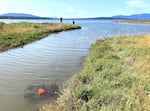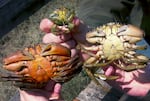On a summer day in 2022, a team of researchers from Portland State University made their way upriver from chilly, salty Siletz Bay, near Lincoln City, to the fresher, warmer waters of the Siletz River.
They were retrieving traps set earlier to see whether invasive European green crabs were finding comfy habitats in places the native Dungeness crabs find intolerable. The alien crabs outcompete Dungeness crabs for both food and habitat and pose a significant danger to that lucrative Oregon fishery.
European green crabs, as the name suggests, are native to Europe. But the hearty, tolerant crustaceans have also made themselves at home in Australia, Argentina, Japan, South Africa and on both coasts of North America.
“Green crabs have incredible tolerances for temperature. They can be much warmer than our native crabs can and thrive. But they’re also pretty successful at cold temperatures,” said Catherine de Rivera, the research team’s leader and PSU professor of environmental sciences and management.
Green crabs are also tolerant of different levels of water salinity, making them feel at home in open sea, estuaries and even up into fresh water. Their flat hind legs make them good swimmers. To top it off, European green crabs possess a set of strong claws that make it easy for them to slice into clam shells and crush the carapaces of lesser-equipped crabs.
These attributes make green crabs excellent survivors and formidable invaders, as well as a significant threat to the state’s shellfish industry.
Oregon’s Dungeness crab fishery brought in upwards of $91 million in the 2021-22 season, and other fisheries such as oysters and bay clams are also at risk of being impacted by the invaders.
“The green crab will take whatever prey is available to them, and it’s easy pickings for them when they get into a good crop of cultivated Pacific oysters,” said Steve Rumrill, shellfish program leader for the Oregon Department of Fish and Wildlife.
Pacific oysters, which originally come from Japan, are the most widely cultivated and harvested shellfish species in the world, including here in Oregon. The presence of a voracious invader such as the green crabs makes oyster growers very nervous.
The negative impacts on oysters are not just economic. Oysters help keep bay water clean; an adult oyster can filter upwards of 50 gallons of water a day.
Green crabs also tear up eelgrass beds that naturally clean ocean water, absorb climate-warming carbon, produce oxygen and provide habitat for sea birds, young Dungeness crabs and other juvenile species. Loss of the grasses disrupts not just fish nurseries, but the ecosystem as a whole.
How did they get here?
Rumrill said experts think European green crabs probably came to the West Coast as fishing bait and in ballast water in the late 1980s, landing first in San Francisco Bay, then moving with ocean currents to new locations.
“They leapfrogged up the California coast into Tomales Bay and Bodega Bay and Humboldt Bay. And from there, continued that northward migration range expansion into Coos Bay,” Rumrill explained.
ODFW began monitoring European green crabs in 1996. Their presence was first noticed in Coos Bay in 1997. Within three or four years, green crabs had colonized all the bays in Oregon and the outer coast of Washington, Rumrill said.
In 2006, “Oregon Field Guide” met up with de Rivera who was working with Oregon State University researcher Sylvia Yamada to document the nascent invasion of green crabs on the Oregon coast. The team found green crabs in several of their traps but suspected the absence of an explosion in population was due to the presence of local native predators.
“Back in 2006, red rock crabs, which is a native crab we have, will prey on them, and they could keep their numbers in check. So we were keeping our eye on them, but we weren’t as worried for Oregon shellfish as we are now,” said de Rivera.

Professor Catherine "Cat" de Rivera of Portland State University collects European green crabs on the shore of Netarts Bay on Feb. 15, 2023.
Jule Gilfillan / OPB
In February, de Rivera was able to find 263 green crabs along the rocky edges of Netarts Bay in about an hour.
“There’s no way we would have seen anything like that in 2006,” said de Rivera.
A new level of threat
The green crab invasion was in its early stages when “Oregon Field Guide” first reported on it in 2006. Since that time, ocean temperatures have warmed, making the environment favorable for green crabs, Rumrill said.
“In 2013, 2014, 2015, the populations have become well established and the numbers of individuals have doubled, quadrupled. So, we’re into what we call the second phase of this widespread West Coast invasion,” he said.
As climate change causes ocean temperatures to grow uncomfortably warm for our native cold-loving species, he said, it’s likely the more tolerant nonnative species will come to dominate local ecosystems.
There goes the neighborhood
While Oregon is being impacted by the presence of the green crabs, it’s Washington state that’s really feeling the creature’s painful pinch.

A program of intensive, year-round trapping at the Lummi Sea Pond near Bellingham, pictured here on July 6, 2023, is part of Washington state’s emergency measures to control European green crabs.
Bobbie Buzzell, Lummi Natural Resources Department
To combat the infestation there, last year the Washington Department of Fish and Wildlife instituted emergency measures to protect the state’s lucrative shellfish industry. The program includes year-round trapping and reported snaring in the neighborhood of a quarter-million green crabs in the last year.
While Oregon’s shellfish industry is orders of magnitude smaller than that of Washington, ODFW has not declared open season on green crabs. In Oregon, there is a harvest limit of 35 crabs, per person, per day, regardless of species. De Rivera thinks there should be no bag limit on green crabs.
“Once people can identify green crabs, then we can remove them and everyone doing their part, removing some green crabs could keep the numbers down,” reasoned de Rivera.
It’s that identification piece that has Oregon’s marine agencies concerned.
“The well-intended person who may go out and try to catch three or 400 green crab, there would likely be unintended bycatch of 30, 40, 50, 60 native crab, and we don’t want that to happen,” said Rumrill. “So, until that time that we are very confident in people’s ability to recognize the native versus nonnative species, we’re comfortable with holding that limit at 35.”
Know your crab
One area where both researchers and agency folks agree is the importance of educating the public about how to identify this pernicious invader. The first thing to know is that green crabs aren’t necessarily green.

Despite their name, European green crabs are not always green. These three crabs pictured on May 11, 2023, are all “green” crabs, demonstrating that color is not a reliable method for identifying the invasive species.
Todd Sonflieth / OPB
“There’s a lot of color variation in the European green crab. See this one is very orange and red,” said Summer Henricksen of ODFW, pointing out an example for the “Oregon Field Guide” camera. “Compare that with this one, also a green crab. It’s kind of a yellow-tan. They can also be quite green. So, using color, it’s impossible to correctly identify them.”
But there is a sure-fire way of telling a native Dungeness from an invasive green crab.

Summer Henricksen of the Oregon Department of Fish and Wildlife points out the five spines characteristic of European green crabs in this photo from May 11, 2023. Using these spines is a reliable way to identify the nonnative crab species.
Todd Sonflieth / OPB
“European green crab have three bumps in between their eyes, and then they have five spines on either side of their eye. Dungeness crab have 10 spines. And it doesn’t change with age or color, so it doesn’t lead to the same misidentification concerns,” Henricksen said.
‘Here to stay’
While researchers like de Rivera watch the clock tick, the time and bureaucratic process involved in formulating a green crab management strategy churns on — a plan Rumrill characterizes as “conceptual planning and early development.”
This month, Rumrill, de Rivera and other partners engaged in developing a framework for devising the “Management Plan for Green Crab in Oregon.”
“This plan is a prerequisite for Oregon to receive federal funds from the U.S. Aquatic Nuisance Species Task Force,” said Rumrill.
The state management plan will identify specific goals and objectives for monitoring and possibly control of the species in Oregon. ODFW wants to continue gathering more data before moving forward with a labor-intensive and costly trapping program, like the one currently underway in Washington.
The department is also looking to identify roles and responsibilities with other agencies such as the Invasive Species Council, Oregon Department of Parks and Recreation, Oregon Department of Agriculture and others, as well as universities and commercial shellfish growers.
If this sounds like a long process to you, you are correct.
In the meantime, researchers like de Rivera look for whatever silver lining they can find.
“(Green crabs) have been on the East Coast for about 200 years and they’re still there,” said de Rivera, noting that other species native to the East Coast seem to be existing along with the invasive species.
“We haven’t seen extinctions because of them. But green crabs are blamed for the crash of the soft-shell clam industry in Maine in the 1950s. And so, they have been shown to impact fisheries,” she added.
In their summer 2022 survey, de Rivera’s team found very few green crabs upriver from Siletz Bay, which might have given them reason for optimism. But just up the coast at the mouth of the Salmon River, they found a thriving population they had not documented before.
While ODFW staff and their partners work through the bureaucracy, Rumrill acknowledges that the time for eradicating invasive green crabs from Oregon shores has passed.
“They are here to stay,” he said.




